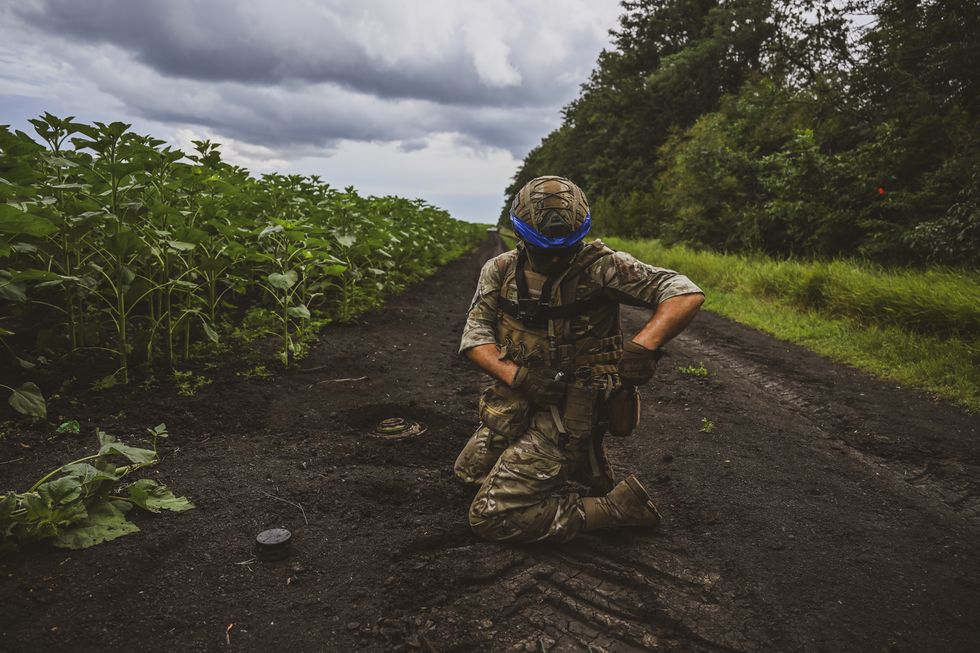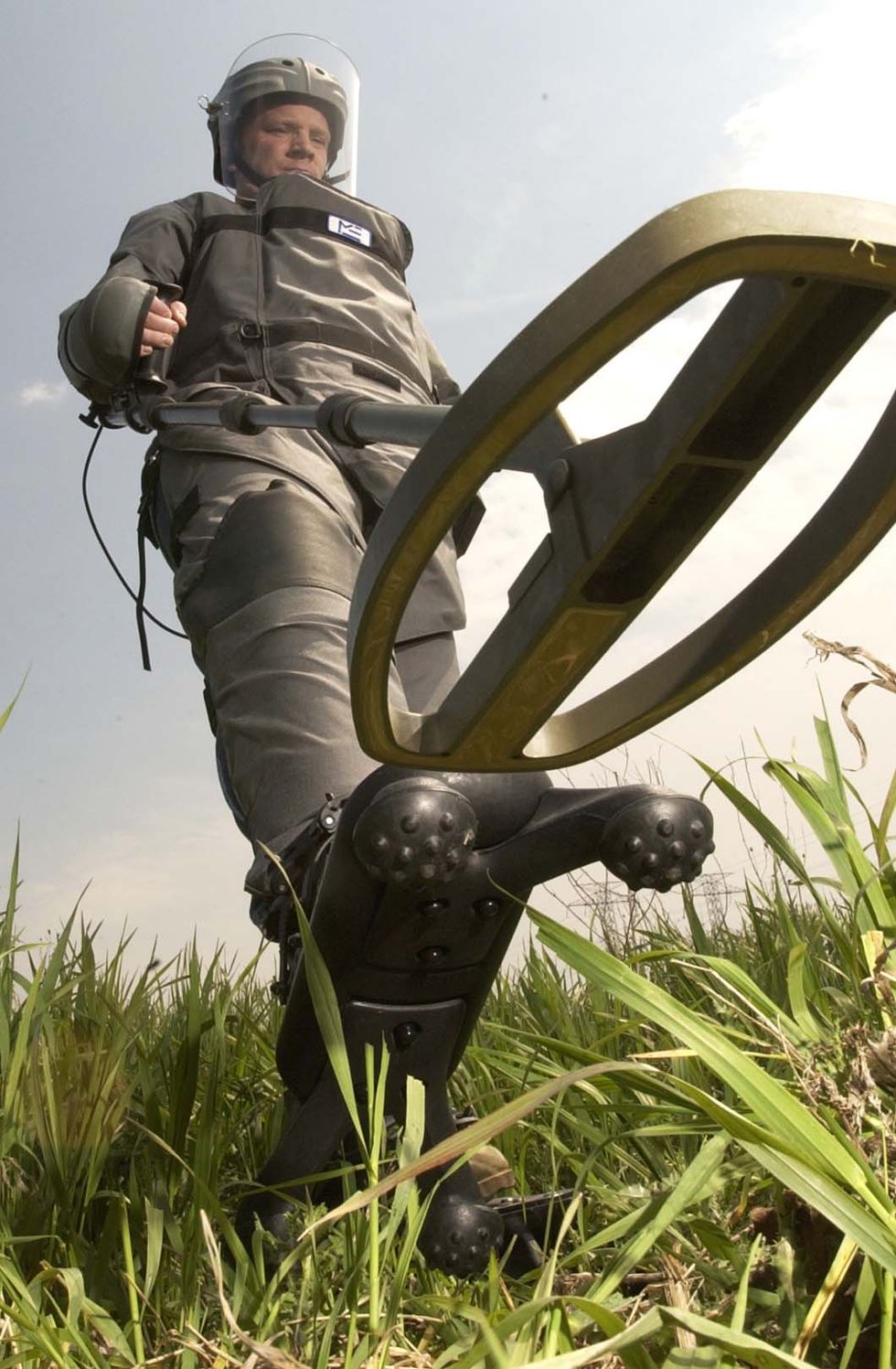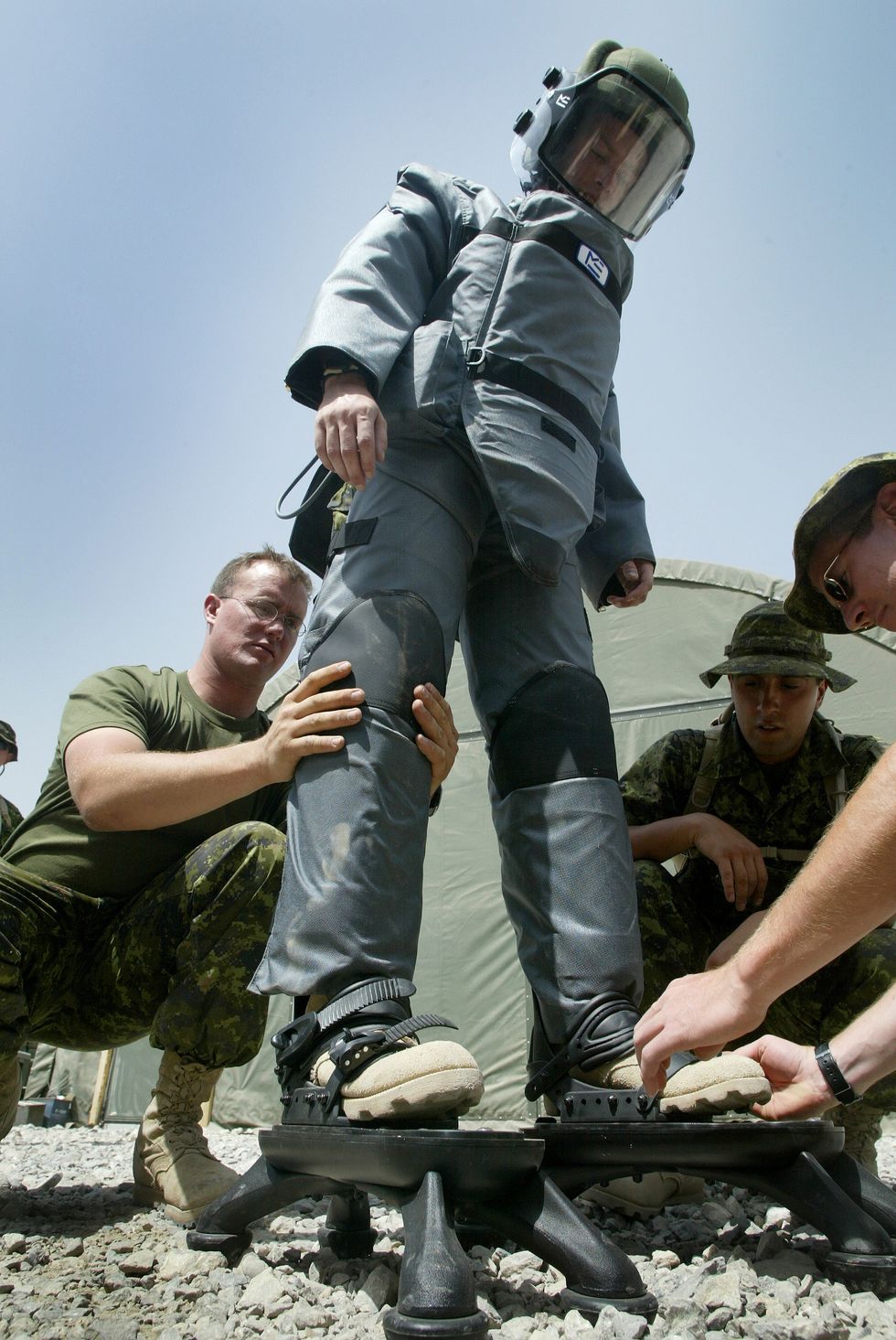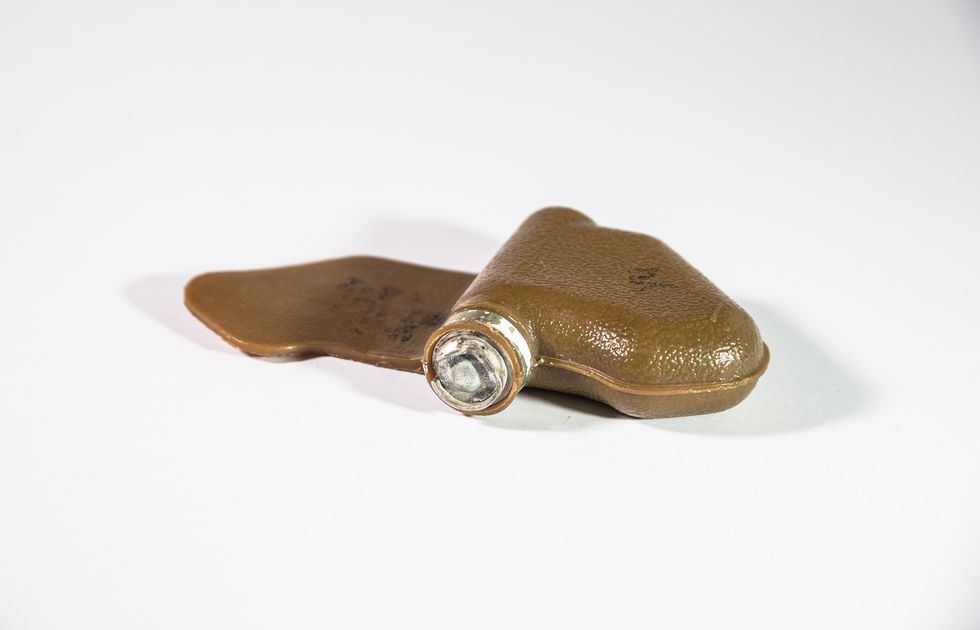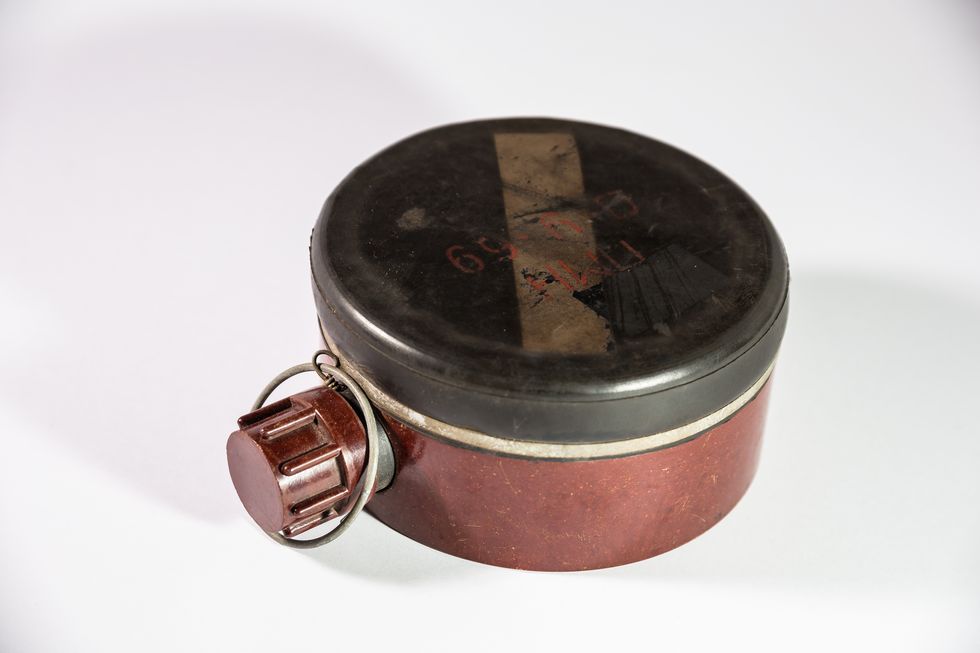“Spider boots” may sound like one of the cool magic items you can find in fantasy games, but this specially-designed four-legged footwear exists in real life, and is literally a matter of saving life and limb.
A recent news segment posted by Reuters highlights how combat engineers of Ukraine’s 128th ‘Transcarpathia’ Mountain Assault brigade are using indigenously produced spider boots strapped over their combat boots to protect themselves from the dense minefields impeding Ukrainian assaults on Russian fortifications in southern Ukraine.
The four-pronged spider boots reduce risks from mines through several mechanisms.
More From Popular Mechanics
First, the boots’ four pod-tipped spider-legs increase the horizontal ‘standoff’ range of a detonating mine, potentially saving feet, legs and groin from a blast discharging directly underneath.
Even more importantly, the spider legs create inches of vertical ‘standoff’ between the ground and the wearer’s foot. The resulting air gap significantly reduces the energy directly transmitted from the blast in the ground to the wearer, including by allowing more of the blast’s energy to vent sideways.
Finally, the boot’s sole shape and materials are designed to deflect and ablatively absorb the resulting energy away from the bearer’s foot and leg.
So, if you step on a typical anti-personnel mine with spider boot, you’ll still probably get hurt—but you’re also far more likely to still have a leg and a foot. And you avoid risking death from blood loss, as often happens after losing limbs.
A recent report by the Wall Street Journal estimates between 20,000 and 50,000 Ukrainians have had limbs amputated since Russia launched its full-scale invasion of Ukraine in February 23, 2022.
Ukraine’s mine warfare nightmare
Ukraine’s new Western-enhanced mechanized brigades were intended to spearhead a long-anticipated summer offensive to liberate territory in southern Ukraine from Russian invaders, one spearheaded by mine-clearing tanks and explosive line-charges that would rapidly blaze a path.
And indeed, in June, several of Ukraine’s Western-equipped brigades tried just that—only to discover that their limited number of valuable mine-clearing tanks were rapidly targeted by overwatching anti-tank guided missiles, attack helicopters, and artillery, stranding the regular vehicles behind them in deadly minefields. Even worse, Russia began employing ISDM Zemledeliye remote minelaying systems at larger scale, which use rockets to shower down up to 600 mines per salvo per vehicle from up to 9 miles away over paths that the Ukrainians had just cleared.
And as for rocket-propelled mine-clearing line charges, they proved highly useful, but inevitably limited in range and quantity.
The losses to valuable fighting vehicles were unacceptable, so Ukraine’s military retired the mass mechanized assault strategy, at least for now.
Instead, the new, slower approach is to send combat engineers in advance of attacks—on foot and often at night—to clear Russia minefields manually using various tools. In this method, the engineers are at risk from both mines and overwatching Russian forces. Reports from the front indicate that this is every bit as terrifying and dangerous as it sounds, and casualties amongst Ukrainian sappers are heavy.
More broadly, Ukraine has indicated that mines, not enemy fire, are still causing most casualties in its counteroffensive. Russian tactics include allowing Ukrainian troops to capture trenches laced full of mines, laying anti-personnel mines under easier-to-spot anti-tank mines, and (according to an account in a Reuter’s segment) concealing anti-personnel mines under piles of dead Russian bodies to maim Ukrainian troops seeking to remove casualties from the field.
The spider boot’s journey from Canada to Ukraine
The spider boot concept has actually been kicking around for roughly a quarter century. It was originally designed by Canadian company Med-Eng systems, which builds personal protective equipment (PPE) for explosives ordinance disposal personnel, like the suits featured in the film The Hurtlocker.
A pair has even remained in the collection of New York’s Metropolitan Museum of Modern Art since 1998. The museum notes that the striking but functional footwear “…incorporates self-sacrificing materials, such as aluminum honeycomb encased in a V-shaped steel container on the underside of the platform to absorb the impact of the detonation.”
A study from 2000 in The Journal of Conventional Weapons Destruction notes that existing “blast boots” for mine protection could protect against weaker mines with 30-50 grams of explosives, but were limited in effectiveness due to their direct physical contact with the mine and ground:
“This contact increases the shock transmission into the sole. Conventional footwear also puts the foot of the deminer directly above the mine in a region where the expanding flow can impart significant kinetic energy to the relatively high mass of the shock attenuator—energy that must then be absorbed by the foot and lower leg. The foot’s relatively close proximity to the explosion also makes it very difficult to select appropriate materials. The extreme pressures in that region exceed the limits of most plastics. As a result, these materials often fail in this pressure regime before they have a chance to perform their job.”
Mounting the footwear on surrogate limbs, the company exposed both old-school blast boots and their spider boots to detonations from charges varying from 25 to 200 grams of C4 (while buried under 30 millimeters of sand) and compared the resulting impact.
They found that the spider boots reduced human leg acceleration by 80-90% against the smallest charges. Photos (seen in article linked above) show that even against larger 200 gram charges, the boots would survive the blast—minus two of their four extended spider legs.
They conclude: “The detonation of 200g C4 or the blast produced by the large AP mines (PMA1 and PMN) is expected to injure the foot inside the boot even when a Spider Boot is used. However, the extent of injury and its treatment will be greatly reduced when compared to conventional mine-protected footwear or a standard combat boot where the foot and lower leg damage are likely to require amputation and extensive rehabilitation.”
Med-Eng produced this so-called Foot Protection System, but it doesn’t appear on the company website for sale today. An old article notes that Chile received some spider boots as military aid in 2003 to assist in de-mining, and a photo the same year shows Canada’s 24th Field Squadron/2nd Combat Engineer Regiment deployed some in Kabul, Afghanistan.
At least sixteen pairs were put up for sale on E-Bay at $499 each, with several still available at time of writing.
Those in Ukraine are produced indigenously. Initially, in 2022, a few pairs of the Canadian-built boots were given to Ukraine’s State Emergency Service. The service then passed on a pair to Ihor Iefymenko, director of Kharkiv-based company Ukrainian Spring Group Center (named after the vehicle springs that it built pre-war).
Over three weeks, he developed a Ukrainian version of the boots. By March of 2023, his company had delivered 10 pairs (7 crowdfunded, three donated) and was working on a follow-up order for 65 more.
Spring Group Center now employs 3D-printers to manufacture components of the boots, which remain time-consuming to build. Reportedly, each pair costs 15,000 hyrvnia (about $406). Ukrainian units are now soliciting donations of these systems. It seems likely, given the circumstances of Ukraine’s counteroffensive, that orders and deliveries of spider boots have scaled up dramatically.
The company has also devised a personal shield to protect sappers from shrapnel.
Soviet anti-personnel land mines
Spring Group Center states that the boots are particularly effective against Soviet PFM-1, PMN-1 and PMN-2—types of anti-personnel mines used by Russia.
The plastic PFM-1, or ‘butterfly mine’, is a relatively flat, leaf-shaped mine just under 5 inches wide and designed to flutter down after being released in the air by a rocket, mortar shell, or aerial cluster bomb. It is allegedly reverse-engineered from American BLU-43 Dragoontooth mine air-dropped during the Vietnam War.
The design has historically been criticized for having a toy-like characteristics likely to tempt children to interact with it, particularly following Soviet use in Afghanistan. Just 11 pounds of pressure suffices to trip the plunger, setting off the mine’s 40-gram liquid explosive charge.
The PMN-1 ‘Black Widow’ mine, by contrast, looks like a small, black pot, standing 2.5 inches tall and 4.5 inches in diameter and made of bakelite, with a black rubber pressure plate. Its large, 250-gram TNT charge can destroy a victim’s leg, and is much more likely to kill or seriously maim its victims than most landmines.
The slightly shallower PMN-2 is similar to the PMN-1, but is green or brown in color, has a raised X-shaped pressure plate on top, and uses a 100-gram charge of TNT/RDX. Its fuse is designed to be much harder to set off using nearby blasts than the 1950s-era PMN-1.
At this point, millions of land mines have been sown in Ukrainian soil, along with countless unexploded non-mine munitions (bombs, rockets, artillery shells, etc.) Were the war to abruptly end tomorrow, there would still remain many years of dangerous explosive demolition disposal ahead to manage the mine-threat and restore to use contaminated agricultural lands.
That disposal will remain a hugely in-demand service that will continue to pose deadly risks to those performing it. And thus, if the spider boots prove successful to reducing risk to life and limb, they may quite literally only grow in prominence in Ukraine and other countries still afflicted by liberally dispersed minefields.
Contributor
Sébastien Roblin has written on the technical, historical, and political aspects of international security and conflict for publications including 19FortyFive, The National Interest, MSNBC, Forbes.com, Inside Unmanned Systems and War is Boring. He holds a Master’s degree from Georgetown University and served with the Peace Corps in China. You can follow his articles on Twitter.



